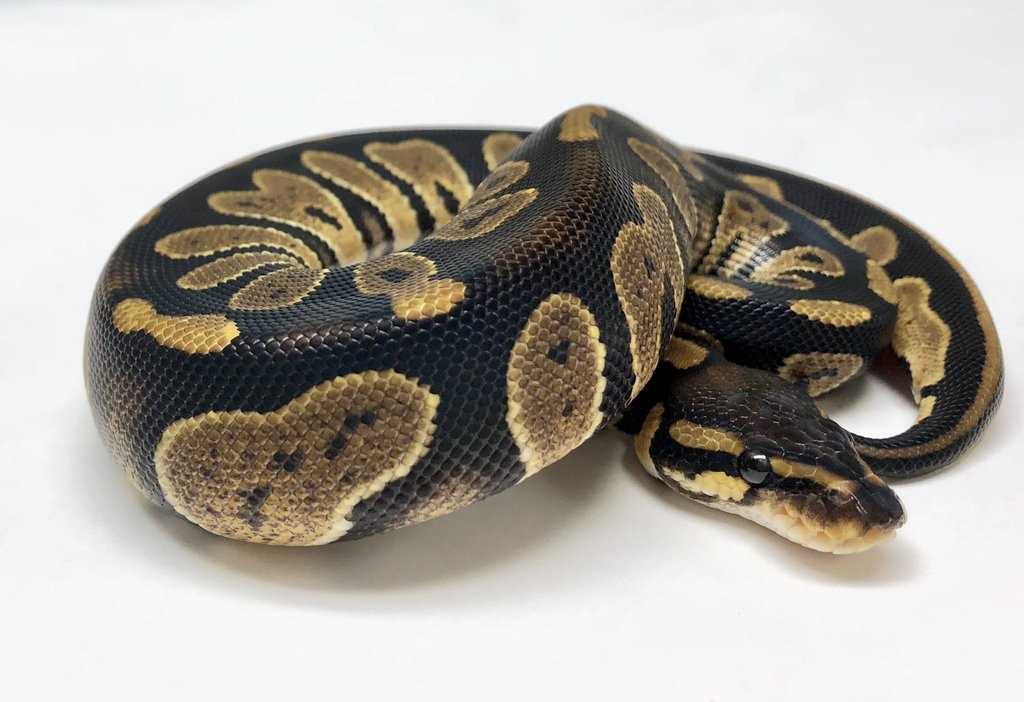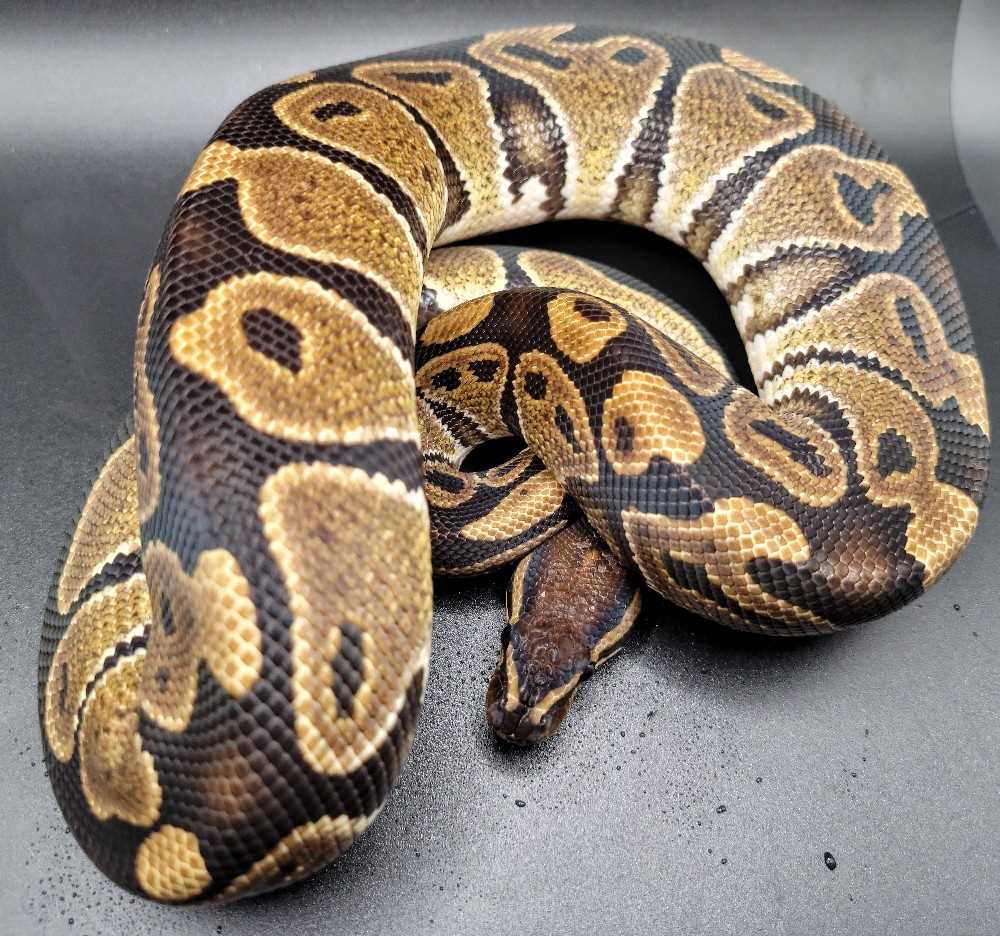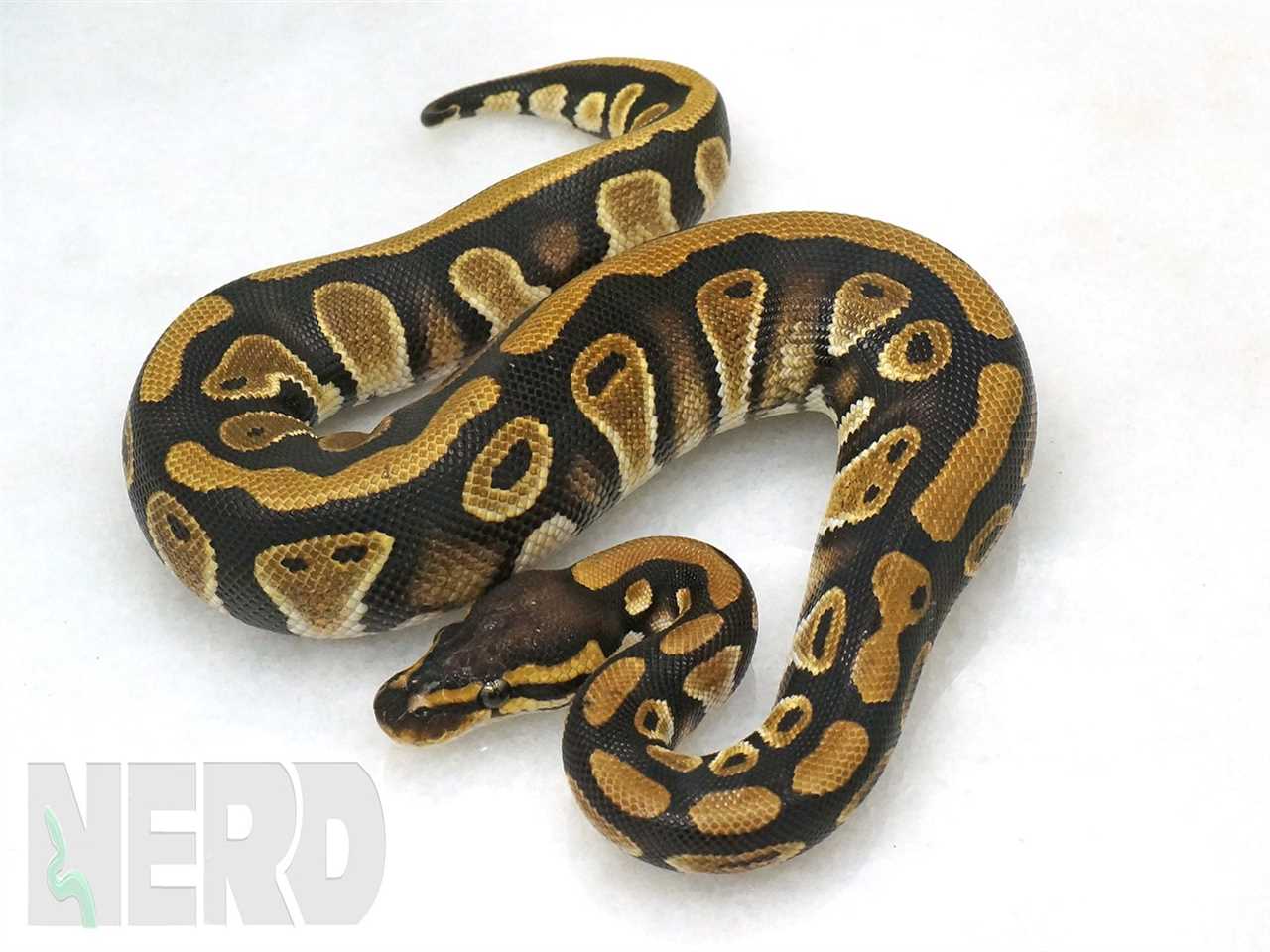What is a Chocolate Ball Python?
A Chocolate Ball Python is a morph of the Ball Python, a popular pet reptile. Morphs are genetic variations of a species that result in unique colors, patterns, and traits. The Chocolate Ball Python is named for its rich, dark brown coloration, resembling the color of chocolate.
Ball Pythons are a type of snake known for their docile nature, making them a favorite choice among reptile enthusiasts. The Chocolate morph is highly sought after for its striking appearance and unique genetic makeup.
As with other Ball Python morphs, the Chocolate variation is a result of selective breeding. Breeders carefully select individuals with desired traits to produce offspring with the same characteristics. This includes the dark brown coloration and any accompanying patterns or markings.
The Chocolate Ball Python is a captivating pet snake that offers a visually stunning addition to any reptile collection. Its beautiful appearance and calm demeanor make it a popular choice among both beginner and experienced reptile keepers.
Appearance
The Chocolate Ball Python is a unique pet snake known for its striking color morph. As its name suggests, this snake has a beautiful chocolate-colored pattern that sets it apart from other reptiles. The chocolate coloration is a result of selective breeding, where specific genes are combined to produce this exquisite color. This makes the Chocolate Ball Python a highly sought-after pet for reptile enthusiasts.
The body of the Chocolate Ball Python is stout and muscular, with a rounded shape that resembles a ball. It has a smooth and glossy appearance, which adds to its overall allure. The snake’s scales are patterned with various shades of brown and dark chocolate, creating a visually captivating effect. The coloration is often accompanied by subtle markings or highlights, which further enhance its beauty.
In addition to its chocolate color, this snake may also exhibit other genetic traits and patterns, such as albino, piebald, or caramel. These variations can result in a range of different appearances, making each Chocolate Ball Python truly unique. Breeders continue to experiment and develop new color morphs, adding even more diversity to this mesmerizing species.
| Physical Traits | Description |
|---|---|
| Color | Variations of brown and dark chocolate |
| Size | Adults can reach lengths of 3 to 5 feet |
| Shape | Rounded and muscular body |
| Skin | Smooth and glossy appearance |
| Patterns | May exhibit subtle markings or highlights |
The Chocolate Ball Python’s unique appearance makes it a true gem among snake enthusiasts. Its mesmerizing coloration and diverse genetic variations add a touch of elegance to any reptile collection.
Genetics and Breeding
The genetics behind the Chocolate Ball Python is fascinating, making it a highly sought after morph in the snake breeding community. This unique coloration is the result of a specific combination of genes.
The Chocolate Ball Python is a co-dominant morph, meaning that when bred with a normal Ball Python, approximately half of the offspring will display the Chocolate coloration. This makes it relatively easy to produce Chocolate Ball Pythons through controlled breeding.
To produce a Chocolate Ball Python, breeders must have a male and female snake that both carry the Chocolate gene. When these two snakes are bred together, there is a 25% chance of producing a Super Chocolate, which exhibits an even deeper and darker coloration than the regular Chocolate Ball Python.
Overall, the genetics behind the Chocolate Ball Python make it a fascinating snake to breed and study. Its unique coloration and genetic traits make it a popular choice among reptile enthusiasts and breeders alike.
Diet and Feeding Habits
Feeding frequency will vary based on the snake’s age and size. Young pythons should be fed weekly, while adults can be fed every 10 to 14 days. It is crucial to monitor the snake’s body condition and adjust feeding accordingly to prevent under or overfeeding. A properly balanced diet is essential for the overall health and well-being of your pet.
During the feeding process, it is recommended to feed the snake in a separate enclosure to prevent them from associating your hand with food. This helps avoid any accidental bites or aggression during feeding time.
Some ball pythons, including the Chocolate morph, may become picky eaters or go off feed for various reasons. This can be concerning for owners, but it is generally not a cause for immediate concern unless weight loss or other health issues occur. If your snake refuses to eat, it is best to monitor their behavior, ensure appropriate husbandry conditions, and consult with a reptile veterinarian if necessary.
Habitat and Enclosure
Creating the Perfect Environment

When setting up the habitat for your chocolate ball python, it is crucial to consider the snake’s natural habitat. In the wild, ball pythons are found in the forests and grasslands of West and Central Africa. They are primarily nocturnal, so they require a comfortable and secure enclosure to thrive.
The Ideal Temperature and Humidity
Ball pythons are ectothermic reptiles, which means they rely on external sources of heat to regulate their body temperature. The temperature gradient within the enclosure is essential for the snake’s thermoregulation. You should provide a warm side and a cooler side in the tank. The warm side should have a temperature between 88-92°F (31-33°C), while the cool side should be around 78-80°F (25-27°C).
Proper humidity levels are also crucial for the health of a chocolate ball python. Aim for a humidity level of around 50-60%. This can be achieved by misting the enclosure daily and providing a water bowl for the snake to soak in.
Substrate and Decor

The substrate you choose for your chocolate ball python should be safe and easy to clean. Popular options include aspen shavings, cypress mulch, or coconut fiber. Avoid any substrate that could cause harm or irritation if ingested by the snake.
Add some decor elements to provide enrichment for your pet snake. This can include climbing branches, rocks, and artificial plants. Ensure that the decor items are securely placed and cannot fall on the snake.
Temperature and Humidity Requirements
Along with temperature, humidity is another crucial factor in a Chocolate Ball Python’s habitat. These snakes require a humidity level of around 50-60%. A digital hygrometer can be used to monitor the humidity levels, and a reptile misting system or daily misting with a spray bottle can help maintain the proper humidity. Adequate humidity is essential for healthy shedding, as it aids in the snake’s ability to shed its skin without complications.
| Temperature | Humidity |
|---|---|
| Day: 80-85°F (27-29°C) | 50-60% |
| Night: 75-80°F (24-27°C) |
Handling and Temperament
When first acquiring a chocolate ball python, it’s advisable to give them some time to acclimate to their new environment. This will help them become more comfortable and less likely to feel threatened during handling sessions.
Dos and Don’ts of Handling a Chocolate Ball Python
Here are some dos and don’ts to keep in mind when handling your chocolate ball python:
- Do: Approach your snake calmly and confidently.
- Do: Support the snake’s entire body when picking it up.
- Do: Be gentle and move slowly when handling your snake.
- Do: Wash your hands before and after handling to prevent the transfer of bacteria.
- Don’t: Squeeze or grasp the snake too tightly.
- Don’t: Startle or make sudden movements around your snake.
- Don’t: Handle your snake for extended periods of time, especially if it shows signs of stress.
- Don’t: Handle your snake if it is in the process of shedding or has recently eaten.
Always be attentive to your snake’s body language while handling. If it becomes agitated or displays signs of stress, such as hissing, coiling, or striking, it’s best to put it back in its enclosure and try again later. Remember, every snake is an individual, so while the chocolate ball python is generally well-tempered, there may be variations in behavior between individuals.
Common Health Issues of Chocolate Ball Pythons
Respiratory Infections

One of the most common health issues in ball pythons, including the chocolate morph, is respiratory infections. These infections can be caused by a variety of factors, including improper temperature and humidity levels, inadequate ventilation, or exposure to drafts.
Digestive Problems
Ball pythons, including chocolate ball pythons, are prone to digestive issues such as regurgitation and constipation. These problems can arise from improper husbandry, inappropriate diet, or internal parasites.
If your chocolate ball python is regurgitating its food or showing signs of constipation, it is crucial to assess its temperature and humidity levels, as well as review its diet. Feeding your snake an appropriate and varied diet consisting of thawed rodents is essential for its digestive health.
Parasites
All ball pythons, including the chocolate morph, are at risk of being infected by internal and external parasites. These parasites may include mites, ticks, worms, and protozoa.
Regularly inspecting your snake for any signs of parasites, such as small black spots on its scales or excessive scratching, is essential. If you suspect that your chocolate ball python has parasites, it is vital to seek veterinary care and follow the appropriate treatment recommendations.
Scale Rot
Scale rot is a common ailment that can affect ball pythons if their enclosure’s humidity levels are too high or if the snake’s bedding is continuously wet. This condition can result in bacterial or fungal growth on the snake’s scales, leading to infections.
To prevent scale rot, it is crucial to maintain adequate ventilation and temperature levels in your chocolate ball python’s habitat. Additionally, ensure that the snake’s substrate is dry and clean at all times to prevent moisture-related issues.
The Lifespan of a Chocolate Ball Python
The lifespan of a Chocolate Ball Python is an important consideration for potential owners. When properly cared for, these snakes can live for an average of 20 to 30 years. However, it’s not uncommon for some individuals to live even longer, with reports of snakes living up to 40 years or more.
In addition to diet, maintaining a suitable habitat and proper environmental conditions is essential for promoting a long and healthy life. This includes providing a spacious enclosure with appropriate hiding spots, maintaining proper temperatures, and ensuring adequate humidity levels.
Regular veterinary check-ups are also important for monitoring the health of your Chocolate Ball Python and addressing any potential issues early on. It’s recommended to find a reptile-experienced veterinarian in your area to ensure proper care and treatment.
It’s worth noting that the lifespan of a Chocolate Ball Python, like any pet, can be influenced by various factors, including genetics, environmental conditions, and overall care. Providing a stress-free and enriched environment, along with proper diet and healthcare, will greatly contribute to the lifespan of your snake.
As with any pet, owning a Chocolate Ball Python is a long-term commitment. Potential owners should be prepared to provide the necessary care and attention for the entirety of the snake’s life, which can span several decades. With proper care, these beautiful and fascinating snakes can bring joy and companionship for many years to come.
Legal Considerations

Some countries, states, or cities may completely ban ownership of certain python species, including the Chocolate Ball Python. This is usually done to protect the local ecosystem and prevent the release of non-native snakes into the wild. Violating these laws can result in fines, confiscation of the snake, or even criminal charges.
Before bringing a Chocolate Ball Python into your home, check with local authorities, such as wildlife or fish and game departments, to ensure that you can legally keep this snake as a pet. It’s better to be safe and informed beforehand rather than facing legal troubles later on.
Additionally, keep in mind that owning a Chocolate Ball Python is a long-term commitment. These snakes can live up to 20 years or more in captivity. Before getting one as a pet, make sure you are prepared to provide the necessary care, attention, and resources for the entire lifespan of the snake.
Tips for Choosing and Caring for a Chocolate Ball Python
In terms of diet, chocolate ball pythons are carnivorous and primarily eat rodents. Provide your snake with appropriately sized mice or rats and ensure that they are properly thawed before feeding. Offer food once every 1-2 weeks, depending on the snake’s age and size.
Regular veterinary check-ups are important to ensure that your chocolate ball python remains healthy. Look out for any signs of illness, such as loss of appetite, weight loss, or changes in behavior. Some common health issues in ball pythons include respiratory infections, mites, and parasites.
| Category | Tips for Choosing and Caring for a Chocolate Ball Python |
|---|---|
| Color and Morph | Choose a chocolate ball python with a vibrant and shiny color. |
| Temperament | Select a snake that is comfortable being handled and shows no signs of aggression. |
| Habitat and Care | Provide an appropriate enclosure with proper heating, hiding spots, and a water dish. |
| Diet | Feed your snake appropriately sized, thawed rodents on a regular basis. |
| Health | Monitor your snake for any signs of illness and seek veterinary care as needed. |
| Legal Considerations | Research and comply with local laws and regulations regarding pet ownership. |
Tips for Choosing and Caring for a Chocolate Ball Python
Choosing a reptile as a pet is an exciting decision, and the chocolate ball python is a popular choice among snake enthusiasts. This unique breed of snake is known for its beautiful chocolate color, making it stand out from other snake morphs.
When selecting a chocolate ball python, there are a few factors to consider. First, ensure that the snake is healthy and has no signs of illness or injury. Look for clear eyes, clean skin, and a well-rounded body shape. It’s also important to choose a snake that is captive-bred rather than wild-caught, as captive-bred snakes tend to be healthier and more accustomed to human interaction.
Once you bring your chocolate ball python home, it’s crucial to create a suitable habitat and enclosure. The enclosure should be large enough for the snake to move around comfortably and include hiding spots, branches, and a water dish. Maintaining the proper temperature and humidity levels is also vital for the snake’s well-being.
Handling your chocolate ball python can be an enjoyable experience, but it’s essential to handle them with care and respect. Snakes are generally solitary creatures and may be stressed by excessive handling. Give your snake time to adjust to its new environment before attempting to handle it, and always support its body to prevent injury.
It’s also crucial to be aware of common health issues that chocolate ball pythons can face, such as respiratory infections or mites. Regular vet check-ups and proper hygiene practices can help prevent these issues. Additionally, providing a clean and sterilized enclosure, along with a balanced diet, can contribute to your snake’s overall health and well-being.
The lifespan of a chocolate ball python can vary, but with proper care, they can live up to 20 years or more. This long lifespan is one reason why owning a chocolate ball python is a long-term commitment that should not be taken lightly.
Before bringing a chocolate ball python into your home, it’s essential to research the legal considerations in your area. Some places may require permits or have restrictions on owning certain exotic animals. Ensure that owning a chocolate ball python is legal and permitted in your location before making a purchase.
Lastly, it’s crucial to consider the cost and availability of chocolate ball pythons. These snakes can vary in price, depending on factors such as age, gender, and genetics. Ensure that you have a budget in place for purchasing and caring for your snake, including food, healthcare, and any necessary equipment.

I’m Lena Adams—a product of an unconventional upbringing in the African wilderness. My father, a daring explorer of African wildlife, sparked my fascination with reptiles, a passion that intertwined with the tragic loss of my mother during an expedition, leaving an indelible mark on my life. Driven to understand the creatures that captivated my parents, I embarked on my journey, sharing insights about reptiles, frogs, and lizards on my website. Through my explorations and conservation efforts, I honour my family’s legacy while seeking connections—to the creatures, nature, and the mother whose presence I yearn to understand.
